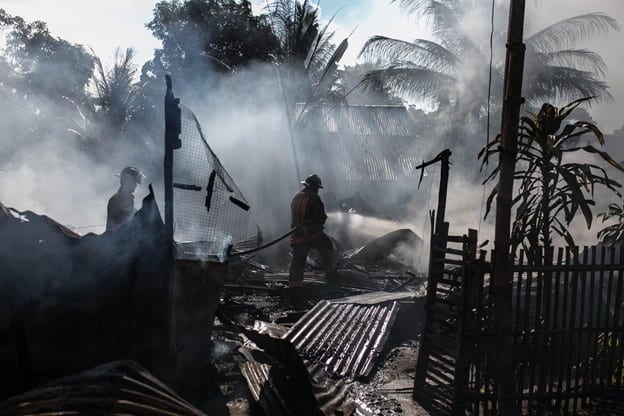Food and nutrition are core elements of survival. Therefore, it is vital to know how to access safe food before, during, and after disasters. Disasters come in different forms and magnitudes and can affect each community differently. While there is little that can be done to prevent disasters, there are many steps that military families may take to prepare themselves for the emergency state brought on by disasters.
“Despite the number of expected natural disasters in the United States (US), many people do not adequately prepare, exposing themselves and their property to the perils of natural disasters.” 1 A study on disaster preparedness among veterans, active duty Navy, and dependents showed that many people who live in disaster-prone areas are not taking the necessary steps to prepare themselves. That is why as educators, it is paramount to teach military families how they should prepare for disaster.
For instance, it is important to consider variations in individual health status when preparing for disasters. Disabilities, allergies, and health complications can create added challenges when it comes to preparing an emergency food supply. To read more about how to aid military families in preparing for disasters, check out Preparing Military Families for Natural Disasters by Utilizing Resiliency Skills by Jennifer Rea, Ph.D.
Disaster Response Diets
Disaster Response Diets (DRDs) are guidelines on what foods are best to consume in response to disasters. The set of food groups selected for DRDs were evaluated based on their nutrient richness, storage and handling, preparation ease, and cultural acceptance/individual tolerance.2
Highest Ranked Food Groups2:
- Dry Cereal
- Nuts
- Dried Fruits
- Grains
- Legumes
- Dry Milk
* Familiar Spices and condiments may also be useful to enhance the cultural acceptance and desire to consume these foods.2
Plant-Based DRDs
A study on food selection criteria for disaster planning concluded that “Plant-based DRDs are universally acceptable and tolerated across cultures and religions. Therefore, we suggest nutrition professionals consider using a plant-based approach for DRD planning for homes, institutions, government agencies, and NGOs.” The plant-based foods listed above meet the highest criteria assessed: nutrient and energy density, cultural acceptance, long shelf-life, occupy little space, easy to handle and prepare, and are affordable. These plant-based foods are an accessible and reliable form of nutrition during disasters.2
Responding to Disasters
While we have already acknowledged the significance of preparing for disasters with nutrient-dense foods that have a long shelf-life, it is also important to consider the long-term nutrition status of these individuals. Food that is designated for disaster preparedness is intended to be a solution from the time the disaster occurs to when life returns to normal. Complications can arise if the disaster affects the food supply of a surrounding area. This makes it more challenging for the people in this area to consume fresher foods which in turn may negatively affect their health status. Many organizations across the US are prepared to help families meet their food and nutrition needs when a disaster occurs.
Disaster Responders Resources to Aid Military Families
There are both governmental and non-government organizations that are prepared to help families across the country in response to disasters. These organizations play a major role in fighting hunger during and after disasters. Listed below are some of the key organizations that play an incremental role in helping families across the US.
Non-Governmental Organizations (NGOs)
The USDA plays a large role in disaster response in the United States. The USDA states that NGOs can use an on-hand inventory of USDA foods stored at state, local, and school warehouses following disasters. These foods may be used for both household and congregate feeding. The following NGOs are designated to respond immediately following a disaster. 3
Governmental Organizations
- D-SNAP
- D-SNAP is the Disaster Supplemental Nutrition Program designated to help families who have lost food supply due to disasters and in need of food assistance. This program is authorized when the president declares a major disaster. States must request approval from the Food and Nutrition Service (FNS) to use D-SNAP.
- Feeding America
- “Feeding America and our network of food banks delivered more than 16.5 million pounds of food, water, and supplies to devastated communities in 2019.”4Feeding America also plays a key role in delivering food and supplies to disaster-struck communities.
Discover more information about disaster responders that will aid military families by checking out the Military Family Readiness Academy.
References
- Annis, H., Jacoby, I., & DeMers, G. (2016, April). Disaster Preparedness among Active Duty Personnel, Retirees, Veterans, and Dependents. Retrieved from https://www.ncbi.nlm.nih.gov/pmc/articles/PMC5069973/
- Wien, M., & Sabaté, J. (2015, May 12). Food selection criteria for disaster response planning in urban societies. Retrieved from https://www.ncbi.nlm.nih.gov/pmc/articles/PMC4489367/#CR18
- USDA Foods During Disaster. (n.d.). Retrieved from https://www.fns.usda.gov/disaster/usda-foods-during-disaster
- How We Respond to Disasters. (n.d.). Retrieved from https://www.feedingamerica.org/our-work/disaster-food-assistance#:~:text=Feeding
Photo by Denniz Futalan from Pexels













